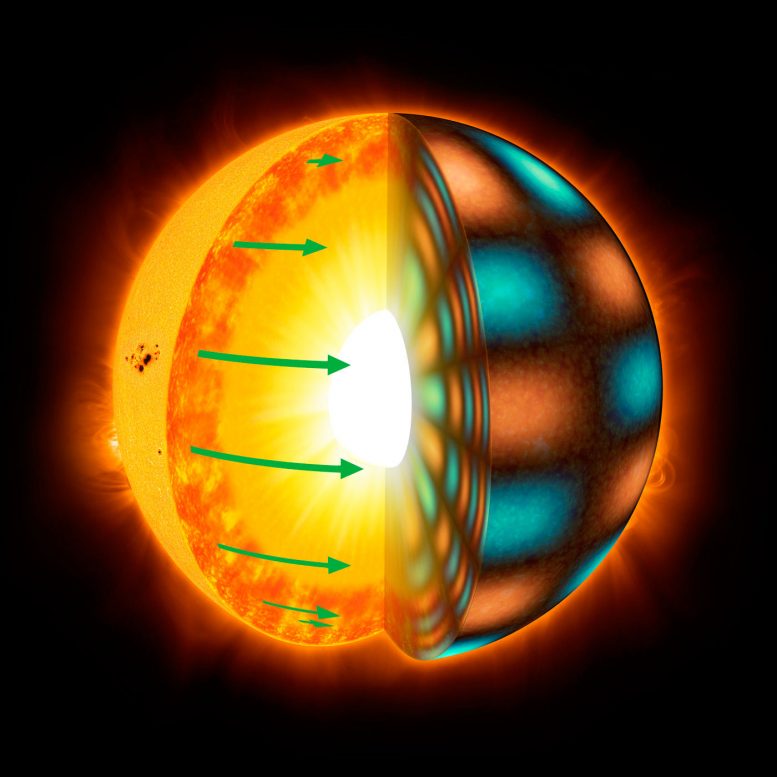
Sun-like stars rotate differentially, with the equator rotating faster than the higher latitudes. The green arrows in the figure represent rotation speed in the stellar convection zone. Differential rotation is inferred from the oscillatory motions of the star seen as orange/blue shades on the right side of the picture. Differential rotation is thought to be an essential ingredient for generating magnetic activity and starspots. Credit: © MPS / MarkGarlick.com
Like our sun, distant stars are rotating spheres of hot gas. Stars, however, do not rotate like solid spheres: regions at different latitudes rotate at different rates. A group of researchers from New York University and the Max Planck Institute for Solar System Research (MPS) in Germany has now measured the rotational patterns of a sample of Sun-like stars. They have identified 13 stars that rotate in a similar fashion as our Sun: their equators rotate faster than their mid-latitudes. This rotation pattern is, however, much more pronounced than in the Sun: the stars’ equators are found to rotate up to twice as quickly as their mid-latitudes. This difference in rotation speed is much larger than theories had suggested.
What do we know about distant stars aside from their brightness and colors? Is our Sun a typical star? Or does it show certain properties that make it special, or maybe even unique? One property that is not fully understood is rotation. In its outer layers the Sun has a rotation pattern that scientists refer to as `latitudinal differential rotation’. This means that different latitudes rotate at different rates. While at the Sun’s equator one full rotation takes approximately 25 days, the higher latitudes rotate more slowly. Near the Sun’s poles, one full rotation takes approximately 31 days.
In their new work, the scientists studied the rotation of 40 stars that resemble the Sun with respect to mass. Among those, the 13 stars for which differential rotation could be measured with confidence all show solar-like differential rotation: equators rotate faster than higher latitudes. In some cases, however, the difference in rotational speed between the equator and the mid-latitudes is much larger than in the Sun.
Classically, stellar rotation is determined by tracking starspots at different latitudes in photometric light curves. This method is limited, however, because we do not know the latitudes of the starspots. “Using observations from NASA’s Kepler mission we can now probe the interior of stars with asteroseismology and determine their rotational profiles at different latitudes and depths,” says Laurent Gizon, director at MPS.
Stars are too far away to be resolved in astronomical images. They are point like. However, scientists can indirectly obtain spatial information about stellar interiors using stellar oscillations. Stars undergo global acoustic oscillations that are excited by convective motions in their outer layers. Different modes of oscillations probe different regions in a star. Thus the frequencies of oscillation inform us about different regions. In this study, the scientists used stellar oscillations to measure rotation at different latitudes in the outer convection zone. “Modes of oscillation that propagate in the direction of rotation move faster than the modes that propagate in the opposite direction, thus their frequencies are slightly different,” says Gizon.
“Our best measurements all reveal stars with solar-like rotation,” says Gizon. The most surprising aspect of this research is that latitudinal differential rotation can be much stronger in some stars than in the Sun. The scientists did not expect such large values, which are not predicted by numerical models.
This work is important as it shows that asteroseismology has fantastic potential to help us understand the inner workings of stars. “Information about stellar differential rotation is key to understanding the processes that drive magnetic activity,” says Gizon. Combining information about internal rotation and activity, together with modeling, will most likely reveal the root causes of magnetic activity in stars. However, many more Sun-like stars must be studied for this to happen. In 2026 the European Space Agency will launch the PLATO mission (an exoplanet mission, like Kepler) to characterize tens of thousands of bright Sun-like stars using precision asteroseismology. Large-number statistics will be key to studying the physics of stars and their evolution.
Publication: “Asteroseismic detection of latitudinal differential rotation in 13 Sun-like stars” by Jo. Benomar, M. Bazot, M. B. Nielsen, L. Gizon, T. Sekii, M. Takata, H. Hotta, S. Hanasoge, K. R. Sreenivasan and J. Christensen-Dalsgaard, 21 September 2018, Science.
DOI: 10.1126/science.aao6571

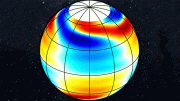
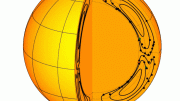

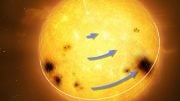
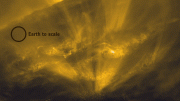
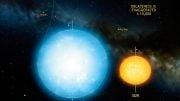
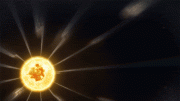
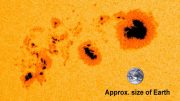
While searching reason behind rotation of the Sun from YouTube and Google, I came to know from a new discovery claim put over the YouTube link given below that phenomenon of faster rotation speed of the Sun at its equator and slower rotation speed near to its Poles has proved that the Sun rotates by the back thrust over its every particle by its outgoing materialistic particles curved rays along with other solar ejects.
Further; above stated phenomenon has also proved (that due to friction created between particles encircling at different speeds), that now the Sun does not rotate by the angular momentum got at its formation from the collapse of the Solar nebula as the World understands.
Moreover, phenomenon that the Sun is a perfect sphere and has not bulged outwards to become oblate due to its faster rotation speed has justified the claim as stated as over the YouTube that the Sun rotates due to the backward thrust over every particle of it by its outgoing materialistic particles curved rays along with other solar ejects.
Discovery claim stated over the YouTube seems to be correct. Please confirm which understanding of the two is correct; existing understanding that Sun rotates by the conservation of angular momentum or as stated over the YouTube under the new discovery.
Official Trailer of New Discovery: Rotation to Sun by its materialistic particles rays. https://www.youtube.com/watch?v=GFmqNLx6Uh0&t=
New Discovery: Rotation to Sun by its materialistic particles rays. https://www.youtube.com/watch?v=EWn0N9D_spw